Digital Poster
Susceptibility I
Joint Annual Meeting ISMRM-ESMRMB & ISMRT 31st Annual Meeting • 07-12 May 2022 • London, UK

| Computer # | ||||
|---|---|---|---|---|
2361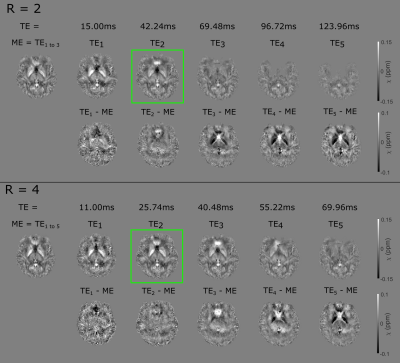 |
97 | Simultaneous Multi-Slice Acceleration of Multi-Echo EPI Provides Rapid and Accurate Quantitative Susceptibility Mapping
Oliver C. Kiersnowski1, Patrick Fuchs1, Stephen J. Wastling2,3, John S. Thornton2,3, and Karin Shmueli1
1Department of Medical Physics & Biomedical Engineering, University College London, London, United Kingdom, 2UCL Queen Square Institute of Neurology, University College London, London, United Kingdom, 3Lysholm Department of Neuroradiology, National Hospital for Neurology and Neurosurgery, London, United Kingdom
Simultaneous multi-slice (SMS) acquisition is increasingly used to accelerate echo planar imaging (EPI). EPI acquisitions have been used for quantitative susceptibility mapping (QSM) but, to utilise SMS, an investigation into the effect of SMS on EPI-QSM accuracy is necessary. Here, we show that SMS has no significant effect on magnetic susceptibility maps and values, and can, therefore, provide accurate QSM within a short TR. We also show, for the first time, that multi-echo phase images can be acquired using an EPI sequence (highly) accelerated using SMS and parallel imaging, leading to more accurate QSM reconstruction compared to standard single-echo EPI.
|
||
2362 |
98 | Isotropic QSM in seconds using super-resolution 2D EPI imaging in 3 orthogonal planes
Beata Bachrata1,2, Steffen Bollmann3,4,5, Günther Grabner1,6,7, Siegfried Trattnig1,2, and Simon Daniel Robinson1,3,8
1High Field Magnetic Resonance Centre, Department of Biomedical Imaging and Image-guided Therapy, Medical University Of Vienna, Vienna, Austria, 2Karl Landsteiner Institute for Clinical Molecular MR in Musculoskeletal Imaging, Vienna, Austria, 3Centre of Advanced Imaging, University of Queensland, Brisbane, Australia, 4University of Queensland, Centre for Innovation in Biomedical Imaging Technology, Brisbane, Australia, 5School of Information Technology and Electrical Engineering, University of Queensland, Brisbane, Australia, 6Department of Medical Engineering, Carinthia University of Applied Sciences, Klagenfurt, Austria, 7Department of Neurology, Medical University Of Vienna, Vienna, Austria, 8Department of Neurology, Medical University of Graz, Graz, Austria We propose a method to generate a super-resolution QSM from three orthogonal 2D EPI acquisitions with anisotropic voxels. Using distortion correction and non-linear co-registration of the individual EPI images with thick slices, a super-resolution EPI image with isotropic voxels was generated and used to compute a QSM. The super-resolution 2D EPI susceptibility maps, as well as the susceptibility values within deep grey matter structures, showed close correspondence to a standard GRE QSM. The net acquisition time was, however, reduced from several minutes to several seconds, allowing QSM in problematic patient cohorts and clinical routine. |
||
2363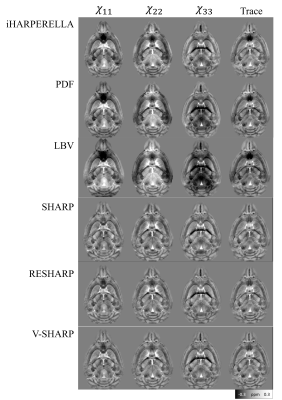 |
99 | Phase filtering methods significantly impact the quality of susceptibility tensor reconstruction
Jingjia Chen1 and Chunlei Liu1,2
1Electrical Engineering and Computer Sciences, University of California, Berkeley, Berkeley, CA, United States, 2Helen Wills Neuroscience Institute, University of California, Berkeley, Berkeley, CA, United States
Phase filtering is a very important step in obtaining a good susceptibility tensor. We compare and illustrate the effects of different phase processing methods on the quality of susceptibility tensor reconstruction with different numbers of orientations. In general, tensor reconstructed from variations of the SHARP phase filtering methods show the most robustness against the large field inhomogeneity and produce tensor elements that are spatially and anatomically more consistent. Compared to the original STI reconstruction, asymmetric STI reduces some of the variations induced by phase filtering methods.
|
||
2364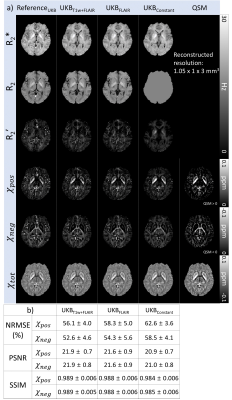 |
100 | Application of susceptibility source separation (chi-separation) to UK Biobank protocol and clinical protocol using deep neural network
Hwihun Jeong1, Sung Suk Oh2, Jongho Lee1, and Hyeong-Geol Shin1
1Department of Electrical and Computer Engineering, Seoul National University, Seoul, Korea, Republic of, 2Medical Device Development Center, K-MEDI hub, Daegu, Korea, Republic of We develop pipelines for reconstructing susceptibility source separation (χ-separation) maps, which requires a T2 map, from UK Biobank protocol and routine clinical protocol data that have no T2 map but have various T2-weighted contrasts (e.g., FLAIR and T2-weighted images). Using these and additional contrast-weighted images, we propose a deep neural network framework that generates an R2 (=1/T2) map, with which χ-separation is conducted. The proposed pipelines successfully generated positive and negative susceptibility maps that are highly similar to gold standard results. The results suggest that χ-separation is applicable to various clinical routine protocols and open-source data. |
||
2365 |
101 | Realistic brain phantom for Susceptibility Tensor Imaging
Nestor Munoz1,2,3, Carlos Milovic4, and Cristian Tejos1,2,3
1Biomedical Imaging Center, Pontificia Universidad Católica de Chile, Santiago, Chile, 2Department of Electrical Engineering, Pontificia Universidad Católica de Chile, Santiago, Chile, 3Nucleo Milenio Cardio MR, Santiago, Chile, 4Department of Medical Physics and Biomedical Engineering, University College, London, United Kingdom
Susceptibility tensor imaging (STI) is a recent MRI technique that is able to quantify anisotropic magnetic susceptibilities in the human tissues. It needs at least 6 acquisitions with different rotation angles to robustly reconstruct each component of a second order tensor. Several methods have been proposed to reconstruct STI, including least squares methods or optimization algorithms. Since there is not a ground truth, it is difficult to evaluate the effectiveness of these algorithms. In this study, we propose a realistic brain human phantom to evaluate and compare different STI reconstruction algorithms.
|
||
2366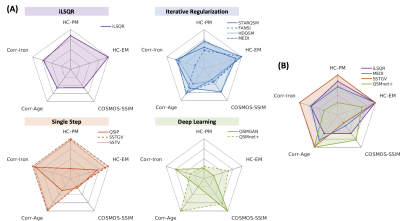 |
102 | Comparison of Quantitative Susceptibility Mapping Methods for Brain Iron Imaging at 7T
Jingwen Yao1, Melanie A. Morrison1, Angela Jakary1, Sivakami Avadiappan1, Yicheng Chen1,2,3, Julia Glueck4, Theresa Driscoll4, Michael Geschwind4, Alexandra Nelson4, Christopher P. Hess1,4, and Janine M. Lupo1,2
1Department of Radiology and Biomedical Imaging, University of California, San Francisco, San Francisco, CA, United States, 2Graduate Program in Bioengineering, UCSF/UC Berkeley, San Francisco, CA, United States, 3Facebook Inc., Mountain View, CA, United States, 4Department of Neurology, University of California, San Francisco, San Francisco, CA, United States
Quantitative susceptibility mapping (QSM) is a promising tool to investigate iron dysregulation in neurodegenerative diseases. A diverse range of methods has been proposed to generate accurate and robust QSM images. In this study, we evaluated the performance of different dipole inversion algorithms for brain iron imaging at 7T, including iLSQR, iterative methods with regularization (STAR-QSM, FANSI, HD-QSM, MEDI), single-step methods (QSIP, SSTV, SSTGV), and deep learning methods (QSMGAN, QSMnet+). We found that SSTV/SSTGV provided the best performance in terms of correlation with age, correlation with iron, and the differentiation between healthy control and premanifest Huntington’s disease individuals.
|
||
2367 |
103 | XSIM, a Susceptibility-Optimised Similarity Index Metric: Validation with 2016 and 2019 QSM Reconstruction Challenge Datasets
Carlos Milovic1,2, Cristian Tejos2,3,4, Pablo Irarrazaval2,3,4,5, and Karin Shmueli1
1Department of Medical Physics and Biomedical Engineering, University College London, London, United Kingdom, 2Department of Electrical Engineering, Pontificia Universidad Catolica de Chile, Santiago, Chile, 3Biomedical Imaging Center, Pontificia Universidad Catolica de Chile, Santiago, Chile, 4Millennium Nucleus for Cardiovascular Magnetic Resonance, Santiago, Chile, 5Institute for Biological and Medical Engineering, Pontificia Universidad Catolica de Chile, Santiago, Chile
The Structural Similarity Index (SSIM) has become a popular quality metric to evaluate Quantitative Susceptibility Mapping (QSM) in a way that is closer to human perception than the Root-Mean-Squared-Error (RMSE). However, SSIM may over-penalize errors in diamagnetic tissues and under-penalize them in paramagnetic tissues. Extreme susceptibility artifacts may also compress the dynamic-range, resulting in unrealistically high SSIM scores (hacking). To overcome these problems we propose XSIM: SSIM implemented in the native QSM ppm range with new susceptibility-optimized internal parameters. We validated XSIM using data from both QSM challenges. XSIM avoids bias and metric-hacking, promoting sharp susceptibility maps and preventing over-regularization.
|
||
2368 |
104 | Brain Health in Preterm Infants: Cerebral Metabolic Rate of Oxygen (CMRO2) Using Advanced MRI
Chen Shuang Zhu1,2, Alexander Mark Weber1,2,3, Ruth E Grunau1,3,4, and Natalie Chan1,3,4
1Institute of Research, BC Children’s Hospital, Vancouver, BC, Canada, 2School of Biomedical Engineering, University of British Columbia, Vancouver, BC, Canada, 3Department of Pediatrics, University of British Columbia, Vancouver, BC, Canada, 4Division of Neonatology, BC Women’s Hospital, Vancouver, BC, Canada
Cerebral metabolic rate of oxygen (CMRO2) is a measurement of oxygen metabolism that may help determine outcomes in preterm neonates and improve treatments. However, limitations exist in current methods for measuring CMRO2. Advanced MRI techniques such as quantitative susceptibility mapping (QSM) may be able to overcome these challenges. GE 3T MRI data of preterm neonates at term equivalent age (TEA) (n=9) was obtained and analyzed using a standard equation to determine the CMRO2. CMRO2 values agreed with literature values and correlated strongly with birth age, but not with birth weight or head circumference at birth.
|
||
2369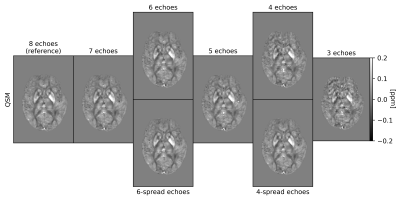 |
105 | The effect of echo train length and TE range on multi-echo quantitative susceptibility mapping.
Antonio Ricciardi1, Anita Karsa2, Carmen Tur1,3, Alberto Calvi1, Sara Collorone1, Francesco Grussu1,4, Marco Battiston1, Rebecca S Samson1, Marios Yannakas1, Jon Stutters1, Baris Kanber1,5, Ferran Prados1,5,6, Karin Shmueli2, and Claudia AM Gandini Wheeler-Kingshott1,7,8
1NMR Research Unit, Queen Square MS Centre, Department of Neuroinflammation, UCL Queen Square Institute of Neurology, University College London, London, United Kingdom, 2Department of Medical Physics and Biomedical Engineering, University College London, London, United Kingdom, 3Multiple Sclerosis Centre of Catalonia (Cemcat), Vall d’Hebron Institute of Research, Vall d’Hebron Hospital Campus, Barcelona, Spain, 4Radiomics Group, Vall d’Hebron Institute of Oncology, Vall d’Hebron Hospital Campus, Barcelona, Spain, 5Centre for Medical Image Computing (CMIC), Department of Medical Physics and Biomedical Engineering, University College London, London, United Kingdom, 6Universitat Oberta de Catalunya, Barcelona, Spain, 7Department of Brain and Behavioral Sciences, University of Pavia, Pavia, Italy, 8Brain Connectivity Centre, IRCCS Mondino Foundation, Pavia, Italy Quantitative susceptibility mapping (QSM) from multi-echo acquisitions provides more accurate results than single echo, but the optimal choice of echo train length and echo time (TE) range requires investigation. In this work, we showed that QSM values depend on the TE range sampled, so QSM data computed over different TE ranges should not be mixed. Dropping later echoes might help resolve echo-to-echo phase inconsistency artifacts, at the expense of QSM accuracy. Finally, in multi-centre studies using data acquired with different TE settings, covering the same total TE range is preferable to simply matching the number of echoes. |
||
2370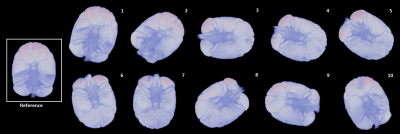 |
106 | COSMOS-Based Susceptibility Estimations: Accuracy Assessment and Comparisons of QSM and Multiple-Angle Acquisitions
Dimitrios G. Gkotsoulias1, Roland Müller 1, Torsten Schlumm1, Niklas Alsleben1, Carsten Jäger1, Jennifer Jaffe2,3, André Pampel1, Catherine Crockford2,3, Roman Wittig2,3, and Harald Möller1
1Max Planck Institute for Human Cognitive and Brain Sciences, Leipzig, Germany, 2Max Planck Institute for Evolutionary Anthropology, Leipzig, Germany, 3Tai Chimpanzee Project, Centre Suisse de Recherches Scientifiques en Cote d'Ivoire, Abidjan, Cote D'ivoire
Calculation Of Susceptibility through Multiple Orientation Sampling (COSMOS) is assessed comparing the optimal, a clinically feasible and multiple-orientation schemes. The optimal COSMOS estimation is used as a gold standard and is compared to the other schemes using the similarity index (SSIM), mean absolute error (MAE) and Pearson’s coefficient (PC). Further comparisons include Thresholded K-space Division (TKD) quantitative susceptibility mapping. For selected white-matter regions, linear regression is used to assess the similarities between the different estimations.
|
||
2371 |
107 | QSM with Implicit Regularisation Using Non-Uniform Fourier Transformation
Patrick Fuchs1 and Karin Shmueli1
1Medical Physics and Biomedical Engineering, University College London, London, United Kingdom
Direct solutions of the dipole inversion problem in quantitative susceptibility mapping (QSM) are computationally efficient but plagued by streaking artifacts. Here, we have shown that non-uniform sampling of frequency space can achieve additional streaking artifact reduction compared to QSM with thresholded k-space division and state-of-the-art regularisation. By avoiding sampling areas in frequency space where the solution is not well defined, the solution of the ill-posed inverse problem is made more robust and noise amplification is reduced. This approach could be combined with compressed sensing techniques to further improve the QSM reconstruction. This research uses open-source tools from the MR community.
|
||
The International Society for Magnetic Resonance in Medicine is accredited by the Accreditation Council for Continuing Medical Education to provide continuing medical education for physicians.